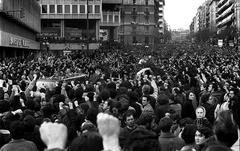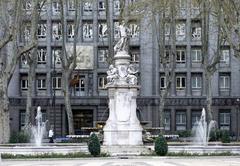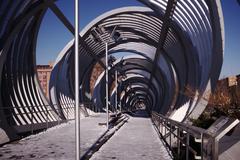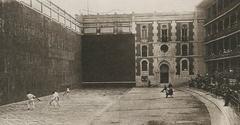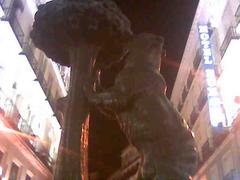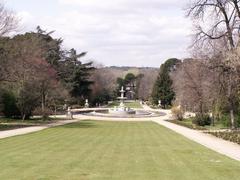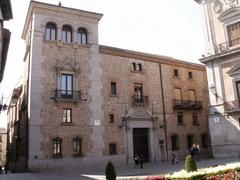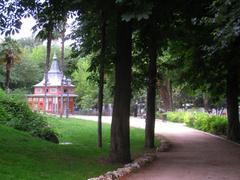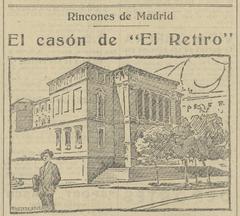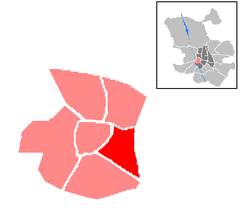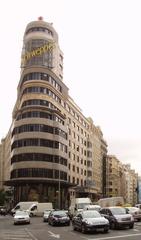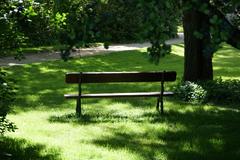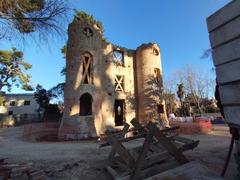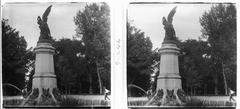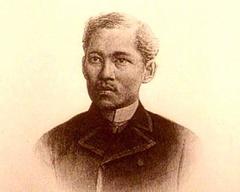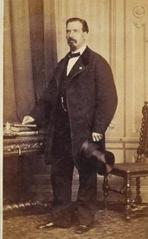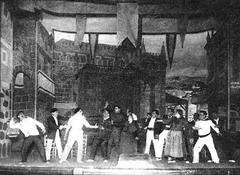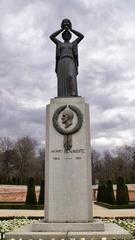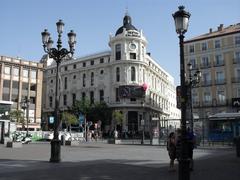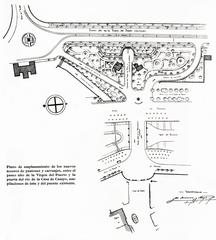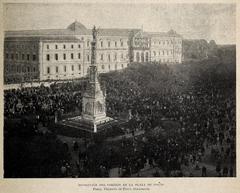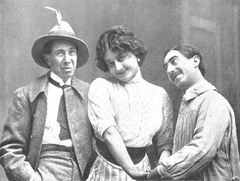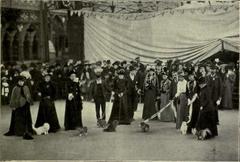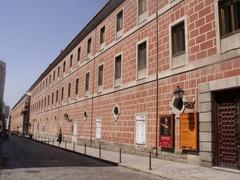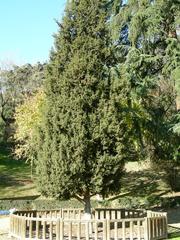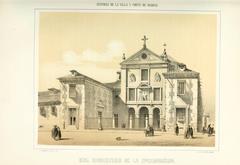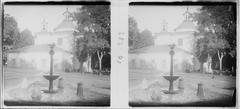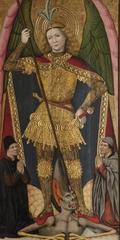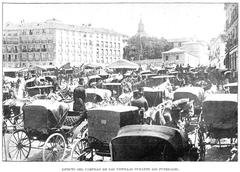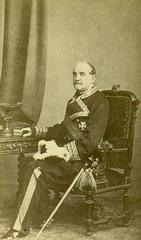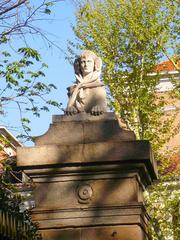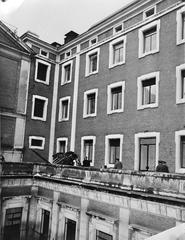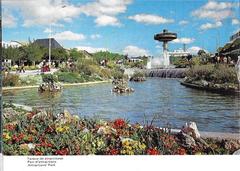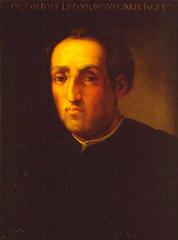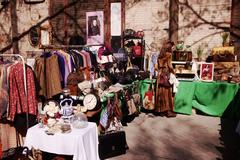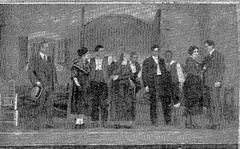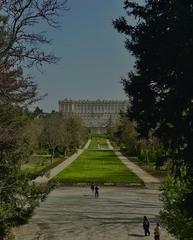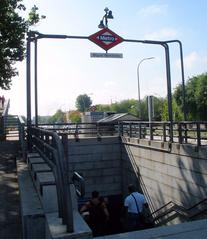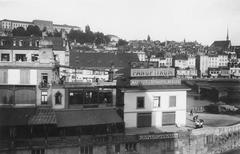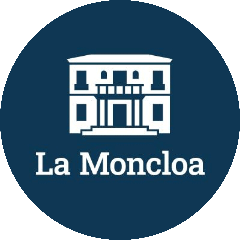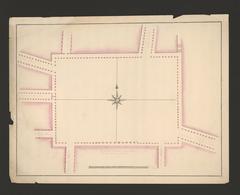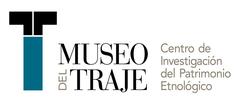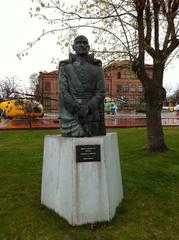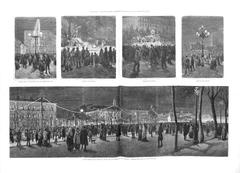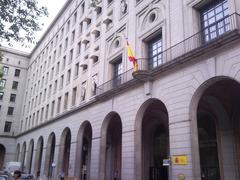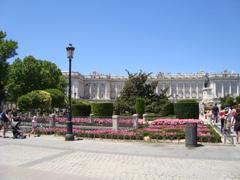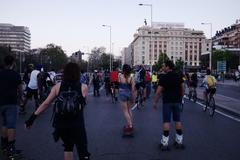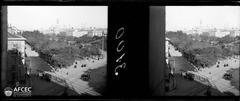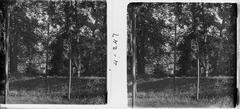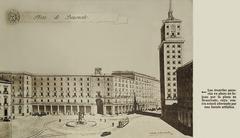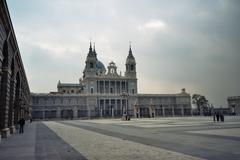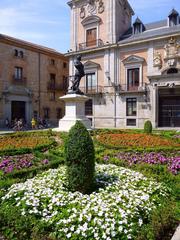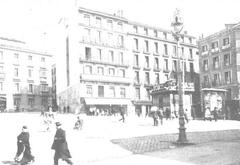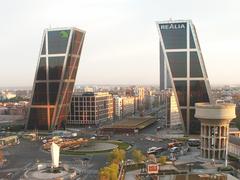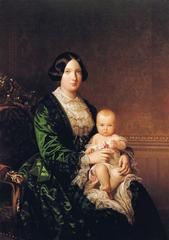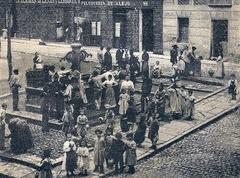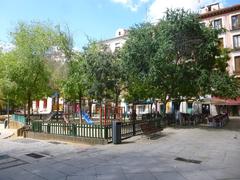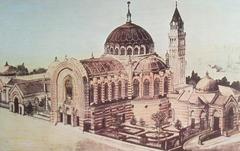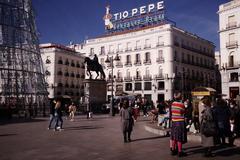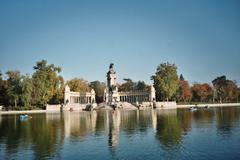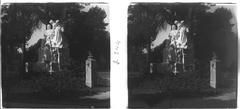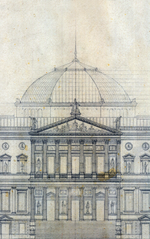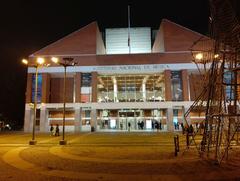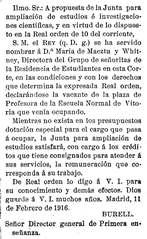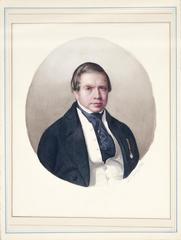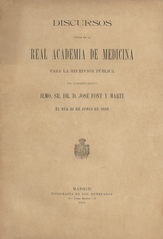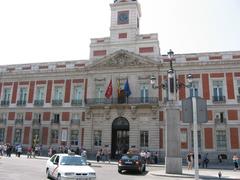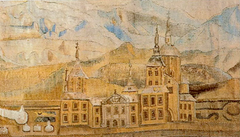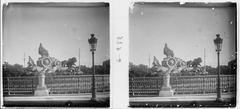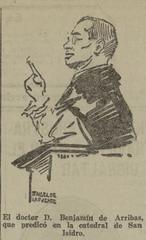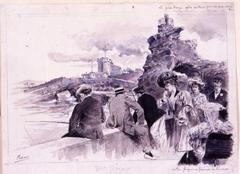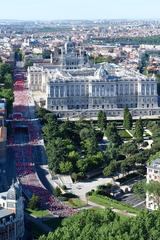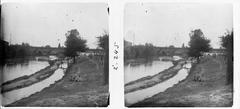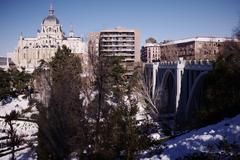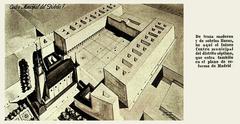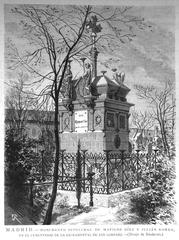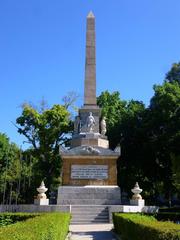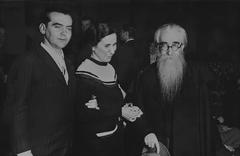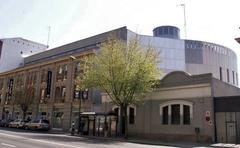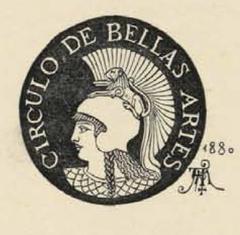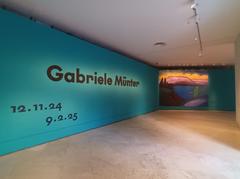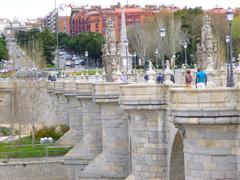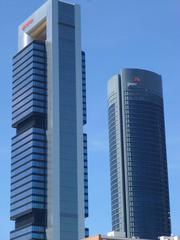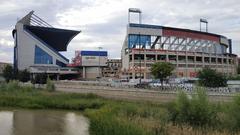
कॉपाकाबाना की हमारी लेडी कॉन्वेंट मैड्रिड: आगंतुक घंटे, टिकट और ऐतिहासिक स्थल गाइड
तिथि: 07/03/2025
परिचय
मैड्रिड के केंद्र में स्थित, कॉपाकाबाना की हमारी लेडी कॉन्वेंट शहर की समृद्ध धार्मिक, सांस्कृतिक और ऐतिहासिक टेपेस्ट्री के प्रमाण के रूप में खड़ी है। 16वीं शताब्दी के अंत और 17वीं शताब्दी की शुरुआत में ऑगस्टिनियन रिकॉलेट्स द्वारा स्थापित, यह कॉन्वेंट एक आध्यात्मिक अभयारण्य और अटलांटिक मैरियन भक्ति का प्रतीक बन गया। वर्जिन ऑफ कॉपाकाबाना - पेरू और बोलीविया की संरक्षक संत - की भक्ति, एंडियन क्षेत्र में उत्पन्न हुई और मैड्रिड लाई गई, जिसने स्वदेशी और कैथोलिक परंपराओं के गहरे तालमेल का प्रतीक बनाया (एलेटिया).
हालांकि 19वीं शताब्दी के धर्मनिरपेक्षीकरण के दौरान मूल कॉन्वेंट भवन खो गए थे, उनकी विरासत मैड्रिड के शहरी परिदृश्य, सांस्कृतिक संस्थानों और धार्मिक समुदायों में बनी हुई है। आज, वास्तुशिल्प अवशेष और आस-पास के स्थल, जैसे कि राष्ट्रीय पुरातत्व संग्रहालय और स्पेन का राष्ट्रीय पुस्तकालय, कॉन्वेंट के स्थायी प्रभाव की एक झलक प्रदान करते हैं (विकिपीडिया).
यह विस्तृत गाइड कॉपाकाबाना की हमारी लेडी कॉन्वेंट की कहानी को समझने और अनुभव करने वाले लोगों के लिए इसके ऐतिहासिक महत्व, वास्तुशिल्प विशेषताओं, सांस्कृतिक विरासत और व्यावहारिक आगंतुक जानकारी की पड़ताल करता है। चाहे आप इतिहास के उत्साही हों, कला प्रेमी हों, या तीर्थयात्री हों, यह गाइड आपको मैड्रिड के सबसे मार्मिक ऐतिहासिक स्थलों में से एक की सराहना करने के लिए आवश्यक सब कुछ प्रदान करता है (लोनली प्लैनेट).
विषय-सूची
- अवलोकन और ऐतिहासिक पृष्ठभूमि
- वास्तुशिल्प और कलात्मक विरासत
- सांस्कृतिक और सामुदायिक प्रभाव
- आज कॉन्वेंट का दौरा: व्यावहारिक जानकारी
- आस-पास के आकर्षण और यात्रा सुझाव
- अक्सर पूछे जाने वाले प्रश्न (FAQ)
- निष्कर्ष और कार्रवाई का आह्वान
- संदर्भ
अवलोकन और ऐतिहासिक पृष्ठभूमि
उत्पत्ति और स्थापना
कॉन्वेंटो डी लॉस अगस्टिनोस रिकॉलेटोस, या कॉन्वेंटो डी कॉपाकाबाना, 1592 में डोना फ्रांसिस्का डी गुज़मान, राजकुमारी ऑफ एस्कुली के संरक्षण के माध्यम से स्थापित किया गया था। ऑगस्टिनियन रिकॉलेट्स, अपने तपस्वी और चिंतनशील जीवन शैली के लिए प्रसिद्ध, ने मैड्रिड के प्राडो विएजो क्षेत्र में कॉन्वेंट की स्थापना की - इसे स्पेन में उनका चौथा घर बनाया और उनके प्रभाव का विस्तार किया। परिसर का निर्माण 17वीं शताब्दी की शुरुआत में वास्तुकार लुइस डी वल्लडोलिड के नेतृत्व में हुआ था, जिसमें फ्राई जुआन डे नुएस्ट्रा सेनोरा डे ला ओ और फ्राई लोरेंजो डे सैन निकोलस का योगदान था, जो स्पेनिश बारोक वास्तुकला में महत्वपूर्ण हस्तियाँ थीं।
मैरियन भक्ति और अटलांटिक कनेक्शन
कॉन्वेंट को कॉपाकाबाना की हमारी लेडी को समर्पित किया गया था, जिसका मूल पंथ बोलीविया में 1583 में फ्रांसिस्को टिटो युपांकई द्वारा तैयार की गई चमत्कारी प्रतिमा के साथ शुरू हुआ था। एंडियन और कैथोलिक परंपराओं का मिश्रण करने वाली यह भक्ति, मिशनरियों और औपनिवेशिक प्रशासकों द्वारा स्पेन लाई गई थी, जिसने पुराने और नए दुनिया के बीच एक आध्यात्मिक पुल बनाया (एलेटिया). 1662 में एक प्रतिकृति प्रतिमा के आगमन ने इस अटलांटिक कनेक्शन को मजबूत किया।
19वीं शताब्दी का धर्मनिरपेक्षीकरण और शहरी परिवर्तन
1830 के दशक में मेंडिज़ाबल के धर्मनिरपेक्षीकरण के कारण कॉन्वेंट को बंद कर दिया गया और ध्वस्त कर दिया गया, जिसकी भूमि सार्वजनिक संस्थानों के लिए पुन: उपयोग की गई। आज, इस स्थल पर स्पेन का राष्ट्रीय पुस्तकालय और राष्ट्रीय पुरातत्व संग्रहालय, साथ ही पাসেओ डी रेकोलेटोस के ब्लॉक स्थित हैं - जिसका नाम इस क्षेत्र के मठवासी अतीत को दर्शाता है (विकिपीडिया).
वास्तुशिल्प और कलात्मक विरासत
स्पेनिश बारोक डिजाइन
कॉन्वेंट प्रारंभिक स्पेनिश बारोक का एक प्रमुख उदाहरण था, जिसमें बंद साइड चैपल के साथ एक एकल-नेव चर्च था। मुख्य मुखौटा में पांच मेहराब और एक त्रिकोणीय पेडिमेंट था, जबकि परिसर में चिंतन के लिए डिज़ाइन किए गए क्लोस्टर, उद्यान और आंगन शामिल थे।
कलात्मक खजाने
कॉपाकाबाना की हमारी लेडी के चैपल में वर्जिन की एक सम्मानित एंडियन-शैली की प्रतिमा थी, जो भव्य रूप से सजी थी और स्थानीय भक्ति के लिए केंद्रीय थी। कॉन्वेंट को फ्रांसिस्को हेरेरा द यंगर, सेबेस्टियन डे ललानोस वाई वाल्डेस, जुआन डे अरेलानो, ल्यूक गिओर्डानो और लुइसा रोल्डन (ला रोल्डाना) जैसे कलाकारों के कार्यों से सजाया गया था, जिससे यह बारोक कला का केंद्र बन गया। धर्मनिरपेक्षीकरण के बाद इनमें से कई खजाने खो गए या बिखर गए, लेकिन उनकी विरासत स्पेनिश धार्मिक कला में बनी हुई है।
सांस्कृतिक और सामुदायिक प्रभाव
शैक्षिक और धर्मार्थ कार्य
कॉन्वेंट ने शिक्षा और दान में महत्वपूर्ण भूमिका निभाई, लड़कियों (विशेषकर औपनिवेशिक पृष्ठभूमि से) के लिए स्कूल चलाए और गरीबों को भिक्षा, आश्रय और चिकित्सा देखभाल प्रदान की। इसने स्पेन और अमेरिका में अनाथालयों और मिशनों में योगदान दिया (विकिपीडिया).
तीर्थयात्रा, उत्सव और लोकप्रिय भक्ति
कॉन्वेंट, विशेष रूप से लैटिन अमेरिकी समुदायों के लिए, तीर्थयात्रा का एक प्रमुख केंद्र था। कॉपाकाबाना की हमारी लेडी का वार्षिक उत्सव 5 अगस्त को जुलूस, संगीत और वस्तुओं के आशीर्वाद के साथ होता था - ये परंपराएं आज मैड्रिड और बोलीविया दोनों में जारी हैं (अनकवर ट्रैवल).
आज कॉन्वेंट का दौरा: व्यावहारिक जानकारी
क्या आप कॉन्वेंट का दौरा कर सकते हैं?
मूल कॉन्वेंट अब मौजूद नहीं है, लेकिन इसकी विरासत क्षेत्र की वास्तुकला और आस-पास के सांस्कृतिक संस्थानों में संरक्षित है। आगंतुक कर सकते हैं:
- 10 रेकोलेटोस स्ट्रीट पर BBVA भवन के आंगन में मूल स्तंभ देखें, जो कभी-कभी कला प्रदर्शनियों के दौरान सुलभ होते हैं।
- स्पेन के राष्ट्रीय पुस्तकालय और राष्ट्रीय पुरातत्व संग्रहालय का दौरा करें, जो दोनों पूर्व कॉन्वेंट के मैदान में स्थित हैं, मैड्रिड की सांस्कृतिक विरासत का पता लगाने के लिए।
घंटे और टिकट
कॉन्वेंट में कोई सीधा प्रवेश नहीं है। BBVA आंगन तक अस्थायी प्रदर्शनियों के दौरान पहुंच संभव हो सकती है - पहले से जांच लें। राष्ट्रीय पुस्तकालय और राष्ट्रीय पुरातत्व संग्रहालय के अपने कार्यक्रम और टिकटिंग नीतियां हैं। मैड्रिड में सामान्य धार्मिक स्थल आमतौर पर सुबह 9:00 बजे से शाम 6:00 बजे तक खुले रहते हैं। हमेशा अद्यतित घंटों के लिए आधिकारिक वेबसाइटों से परामर्श करें (esmadrid.com).
पहुंच
पैसेओ डी रेकोलेटोस के आसपास का क्षेत्र व्हीलचेयर-सुलभ है और सार्वजनिक परिवहन द्वारा अच्छी तरह से सेवित है। संग्रहालय और सांस्कृतिक स्थल कम गतिशीलता वाले आगंतुकों के लिए सेवाएं प्रदान करते हैं।
वहाँ कैसे पहुँचें
- मेट्रो: बैंको डी एस्पाना (लाइन 2) और कोलोन (लाइन 4) पास में हैं।
- बस: कई लाइनें पাসেओ डी रेकोलेटोस पर सेवित हैं।
- पैदल: स्थान केंद्रीय है और मैड्रिड के मुख्य आकर्षणों से आसानी से पहुँचा जा सकता है।
आस-पास के आकर्षण और यात्रा सुझाव
- पैसेओ डी रेकोलेटोस: सैर के लिए एक सुंदर बुलेवार्ड।
- राष्ट्रीय पुरातत्व संग्रहालय: स्पेनिश पुरातत्व का अन्वेषण करें।
- स्पेन का राष्ट्रीय पुस्तकालय: प्रदर्शनियों और दुर्लभ संग्रह देखें।
- प्लाजा डी सिबेलेस: पास में मैड्रिड का प्रतिष्ठित प्रतीक।
- साहित्यिक क्वार्टर और प्राडो संग्रहालय: पैदल दूरी के भीतर (लोनली प्लैनेट).
सुझाव:
- धार्मिक स्थानों पर जाते समय शालीनता से कपड़े पहनें।
- यात्राओं के लिए सप्ताह के दिनों की सुबह शांत होती है।
- मैड्रिड की धार्मिक विरासत पर केंद्रित निर्देशित पैदल यात्राओं पर विचार करें।
अक्सर पूछे जाने वाले प्रश्न (FAQ)
Q: क्या मैं कॉपाकाबाना की हमारी लेडी के मूल कॉन्वेंट का दौरा कर सकता हूं? A: कॉन्वेंट को 19वीं शताब्दी में ध्वस्त कर दिया गया था। आगंतुक अवशेष (जैसे BBVA भवन में स्तंभ) देख सकते हैं और आस-पास के संग्रहालयों में साइट के इतिहास का पता लगा सकते हैं।
Q: क्या प्रवेश शुल्क है? A: बाहरी अवशेषों को देखने के लिए कोई शुल्क नहीं है। संग्रहालयों को टिकट की आवश्यकता हो सकती है।
Q: क्या निर्देशित दौरे उपलब्ध हैं? A: हाँ, मैड्रिड के कई ऐतिहासिक और धार्मिक दौरे कॉन्वेंट की विरासत को शामिल करते हैं।
Q: क्या यह क्षेत्र विकलांग लोगों के लिए सुलभ है? A: हाँ, क्षेत्र और आस-पास के संग्रहालय सुलभ हैं।
Q: वहां जाने का सबसे अच्छा तरीका क्या है? A: मेट्रो (बैंको डी एस्पाना या कोलोन), बस, या मध्य मैड्रिड से पैदल चलकर।
निष्कर्ष और कार्रवाई का आह्वान
कॉपाकाबाना की हमारी लेडी कॉन्वेंट धार्मिक भक्ति, कलात्मक वैभव और शहरी परिवर्तन की एक बहुआयामी विरासत को एक साथ बुनती है। यद्यपि इसकी भौतिक संरचना अब मौजूद नहीं है, इसकी स्मृति वास्तुशिल्प खंडों, स्थान-नामों और कॉपाकाबाना की हमारी लेडी की चल रही भक्ति में जीवित है। इस क्षेत्र की खोज मैड्रिड के स्तरित अतीत और स्पेन और लैटिन अमेरिका को जोड़ने वाले आध्यात्मिक बंधनों पर एक अनूठा लेंस प्रदान करती है।
आगंतुक घंटों, टिकटों और पर्यटन के बारे में नवीनतम जानकारी के लिए, आधिकारिक पर्यटन वेबसाइटों पर जाएं या इंटरैक्टिव नक्शे और सांस्कृतिक अंतर्दृष्टि के लिए ऑडिएला ऐप डाउनलोड करें। मैड्रिड की धार्मिक और ऐतिहासिक खजानों की अपनी खोज जारी रखें, हमारे संबंधित लेखों और सोशल मीडिया चैनलों का अनुसरण करें।
संदर्भ
- कॉपाकाबाना की चमत्कारी प्रतिमा के पीछे की विनम्र कहानी, 2017, एलेटिया (एलेटिया)
- मैड्रिड में मठों की सूची, विकिपीडिया (विकिपीडिया)
- मैड्रिड की यात्रा करने से पहले जानने योग्य बातें, लोनली प्लैनेट (लोनली प्लैनेट)
- कार्यक्रम कैलेंडर, esmadrid.com (esmadrid.com)
- कॉपाकाबाना की हमारी लेडी, अनकवर ट्रैवल (अनकवर ट्रैवल)
- कॉपाकाबाना की हमारी लेडी, digitalmissioners.com (digitalmissioners.com)
- मैड्रिड में मठ, spain.info (spain.info)
- बेयरफुट नन्स कॉन्वेंट, मैड्रिड म्यूजियम टूर्स (मैड्रिड म्यूजियम टूर्स)
- मैड्रिड में करने योग्य सर्वोत्तम चीजें, अर्थ ट्रेकर्स (अर्थ ट्रेकर्स)
- जुलाई में मैड्रिड में करने योग्य चीजें, मैड्रिड ट्रैवलर (मैड्रिड ट्रैवलर)
ऑडिएला2024{‘date’: ‘03/07/2025’, ‘task’: {‘model’: ‘gpt-4.1-mini’, ‘query’: ‘Comprehensive guide to visiting Convent Of Our Lady Of Copacabana, Madrid, Spain: history, significance, visitor tips, and everything tourists need to know for a memorable experience.’, ‘verbose’: False, ‘guidelines’: [“Keyword Research: Identify relevant keywords that potential visitors are likely to search for, such as ‘[Monument Name] visiting hours,’ ‘[Monument Name] tickets,’ and ‘[City] historical sites.’ Use these keywords strategically throughout the article, including in the title, headers, and body text, but avoid keyword stuffing.”, ‘Engaging and Informative Title: Craft a title that is both SEO-friendly and compelling to encourage clicks. Include the main keyword and make it clear what the article will cover.’, ‘Structured Content: Use headings (H1, H2, H3) to organize the content effectively. This helps with SEO and makes the article easier for readers to navigate. Include an introduction that hooks the reader, a detailed body that covers all relevant aspects, and a conclusion that summarizes the key points.’, ‘Comprehensive Coverage: Address common questions and topics of interest such as the history of the monument, its cultural significance, visitor information (e.g., ticket prices, opening hours), travel tips, nearby attractions, and accessibility. Include sections that might be unique to the monument, like special events, guided tours, and photographic spots.’, ‘Quality Content: Ensure the content is well-researched, accurate, and provides real value to readers. Use reliable sources and provide factual information. Write in a clear, engaging, and accessible style. Consider your audience and use people that are likely to visit the monument.’, ‘Visuals and Media: Incorporate high-quality images or videos of the monument. These should be optimized for the web (correct sizing, alt tags with keywords). Consider interactive elements like virtual tours or maps.’, ‘Internal and External Links: Include links to other related articles on your site to encourage deeper engagement (internal links). Link to official websites for the monument or credible sources for further reading (external links).’, ‘FAQ: Incorporate FAQ sections to target voice search queries and featured snippets’, ‘Visit and Stay Up to Date: End the article with a call to action, such as encouraging readers to download our mobile app Audiala, check out other related posts, or follow on social media for more updates.’], ‘max_sections’: 4, ‘publish_formats’: {‘pdf’: False, ‘docx’: False, ‘markdown’: True}, ‘follow_guidelines’: True}, ‘title’: ‘A Comprehensive Guide to Visiting the Convent of Our Lady of Copacabana, Madrid, Spain’, ‘report’: ’# Convent of Our Lady of Copacabana Madrid: Visiting Hours, Tickets, and Historical Sites Guide\n\n#### Date: 03/07/2025\n\n## Introduction\n\nNestled in the heart of Madrid, the Convent of Our Lady of Copacabana stands as a testament to the city’s rich religious, cultural, and historical tapestry. Established by the Augustinian Recollects in the late 16th and early 17th centuries, the convent became a spiritual sanctuary and a symbol of transatlantic Marian devotion. The veneration of the Virgin of Copacabana—patron saint of Peru and Bolivia—originated in the Andean region and was brought to Madrid, symbolizing a profound syncretism of indigenous and Catholic traditions (Aleteia).\n\nAlthough the original convent buildings were lost during the 19th-century secularization, their legacy endures in Madrid’s urban landscape, cultural institutions, and religious communities. Today, architectural remnants and nearby landmarks, such as the Museo Arqueológico Nacional and the National Library of Spain, offer a window into the convent’s enduring influence (Wikipedia). \n\nThis detailed guide explores the historical significance, architectural features, cultural legacy, and practical visitor information for those seeking to understand and experience the story of the Convent of Our Lady of Copacabana. Whether you are a history enthusiast, an art lover, or a pilgrim, this guide provides all you need to appreciate one of Madrid’s most evocative historical sites (Lonely Planet).\n\n---\n\n## Table of Contents\n\n1. Overview and Historical Background\n2. Architectural and Artistic Legacy\n3. Cultural and Community Impact\n4. Visiting the Convent Today: Practical Information\n5. Nearby Attractions and Travel Tips\n6. Frequently Asked Questions (FAQ)\n7. Conclusion and Call to Action\n8. References\n\n---\n\n## Overview and Historical Background\n\n### Origins and Foundation\n\nThe Convento de los Agustinos Recoletos, or Convento de Copacabana, was founded in 1592 through the patronage of Doña Francisca de Guzmán, Princess of Asculi. The Augustinian Recollects, renowned for their austere and contemplative lifestyle, established the convent in the Prado Viejo area of Madrid—making it their fourth house in Spain and expanding their influence. Construction of the complex began in the early 17th century, led by architect Luis de Valladolid, with contributions from Friar Juan de Nuestra Señora de la O and Friar Lorenzo de San Nicolás, who were pivotal figures in Spanish Baroque architecture.\n\n### Marian Devotion and Transatlantic Connection\n\nThe convent was dedicated to Our Lady of Copacabana, whose original cult began in Bolivia with the miraculous statue crafted by Francisco Tito Yupanqui in 1583. This devotion, blending Andean and Catholic traditions, was brought to Spain by missionaries and colonial administrators, forging a spiritual bridge between the Old and New Worlds (Aleteia). The arrival of a replica statue in 1662 solidified this transatlantic connection.\n\n### 19th-Century Secularization and Urban Transformation\n\nThe Ecclesiastical Confiscations of Mendizábal in the 1830s led to the closure and demolition of the convent, with its lands repurposed for public institutions. Today, the site hosts the National Library of Spain and the Museo Arqueológico Nacional, as well as blocks along Paseo de Recoletos—whose name reflects the area’s monastic past (Wikipedia).\n\n---\n\n## Architectural and Artistic Legacy\n\n### Spanish Baroque Design\n\nThe convent was a prime example of early Spanish Baroque, featuring a single-nave church with closed side chapels. The main façade boasted five arches and a triangular pediment, while the complex included cloisters, gardens, and courtyards designed for reflection.\n\n### Artistic Treasures\n\nThe Chapel of Our Lady of Copacabana housed a revered Andean-style statue of the Virgin, lavishly adorned and central to local devotion. The convent was decorated with works by artists such as Francisco Herrera the Younger, Sebastián de Llanos y Valdés, Juan de Arellano, Luca Giordano, and Luisa Roldán (La Roldana), making it a center of Baroque art. Many of these treasures were lost or dispersed following secularization, but their legacy endures in Spanish religious art.\n\n---\n\n## Cultural and Community Impact\n\n### Educational and Charitable Work\n\nThe convent played an important role in education and charity, operating schools for girls (especially those from colonial backgrounds) and providing alms, shelter, and medical care to the poor. It contributed to orphanages and missions in Spain and the Americas (Wikipedia).\n\n### Pilgrimage, Festivities, and Popular Devotion\n\nThe convent was a major center of pilgrimage, particularly for Latin American communities. The annual feast of Our Lady of Copacabana on August 5th featured processions, music, and the blessing of objects—traditions that continue today both in Madrid and Bolivia (Uncover Travel).\n\n---\n\n## Visiting the Convent Today: Practical Information\n\n### Can You Visit the Convent?\n\nThe original convent no longer stands, but its legacy is preserved in the area’s architecture and nearby cultural institutions. Visitors can:\n\n- See original columns in the BBVA building courtyard at 10 Recoletos Street, sometimes accessible during art exhibitions.\n- Visit the National Library of Spain and Museo Arqueológico Nacional, both located on the former convent’s grounds, to explore Madrid’s cultural heritage.\n\n### Hours and Tickets\n\nThere is no direct entry to the convent itself. Access to the BBVA courtyard may be possible during temporary exhibitions—check in advance. The National Library and Museo Arqueológico Nacional have their own schedules and ticketing policies. General religious sites in Madrid are usually open from 9:00 AM to 6:00 PM. Always consult official websites for up-to-date hours (esmadrid.com).\n\n### Accessibility\n\nThe area around Paseo de Recoletos is wheelchair accessible and well-served by public transport. Museums and cultural sites offer services for visitors with reduced mobility.\n\n### Getting There\n\n- Metro: Banco de España (Line 2) and Colón (Line 4) are nearby.\n- Bus: Multiple lines serve Paseo de Recoletos.\n- On foot: The location is central and easily reached from Madrid’s main attractions.\n\n---\n\n## Nearby Attractions and Travel Tips\n\n- Paseo de Recoletos: A scenic boulevard perfect for walks.\n- Museo Arqueológico Nacional: Explore Spanish archaeology.\n- National Library of Spain: See exhibitions and rare collections.\n- Plaza de Cibeles: A Madrid icon nearby.\n- Literary Quarter and Prado Museum: Within walking distance (Lonely Planet).\n\nTips:\n- Dress modestly if visiting religious spaces.\n- Weekday mornings are quieter for visits.\n- Consider guided walking tours focused on Madrid’s religious heritage.\n\n---\n\n## Frequently Asked Questions (FAQ)\n\nQ: Can I visit the original Convent of Our Lady of Copacabana? \nA: The convent itself was demolished in the 19th century. Visitors can see remnants (such as columns in the BBVA building) and explore the site’s history at nearby museums.\n\nQ: Is there an entrance fee? \nA: There is no fee to see the exterior remains. Museums may require tickets.\n\nQ: Are there guided tours? \nA: Yes, several Madrid historical and religious tours include the convent’s legacy.\n\nQ: Is the area accessible for people with disabilities? \nA: Yes, the area and nearby museums are accessible.\n\nQ: What is the best way to get there? \nA: By metro (Banco de España or Colón), bus, or walking from central Madrid.\n\n---\n\n## Conclusion and Call to Action\n\nThe Convent of Our Lady of Copacabana weaves together a story of religious devotion, artistic splendor, and urban transformation. Though its physical structure is gone, its memory survives in architectural fragments, place-names, and the ongoing veneration of Our Lady of Copacabana. Exploring this area offers a unique lens on Madrid’s layered past and the spiritual bonds linking Spain to Latin America.\n\nFor up-to-date information on hours, tickets, and tours, visit official tourism websites or download the Audiala app for interactive maps and cultural insights. Continue your discovery of Madrid’s religious and historical treasures by following our related articles and social media channels.\n\n---\n\n## References\n\n- The humble story behind the miraculous statue of Our Lady of Copacabana, 2017, Aleteia (Aleteia)\n- List of monasteries in Madrid, Wikipedia (Wikipedia)\n- Things to know before traveling to Madrid, Lonely Planet (Lonely Planet)\n- Events Calendar, esmadrid.com (esmadrid.com)\n- Our Lady of Copacabana, Uncover Travel (Uncover Travel)\n- Our Lady of Copacabana, digitalmissioners.com (digitalmissioners.com)\n- Monastery of Las Descalzas Reales, Spain.info (Spain.info)\n- Barefoot Nuns Convent, Madrid Museum Tours (Madrid Museum Tours)\n- Best things to do in Madrid, Earth Trekkers (Earth Trekkers)\n- Things to do in Madrid in July, Madrid Traveller (Madrid Traveller)\n\n---\n\n’, ‘headers’: {‘date’: ‘Date’, ‘title’: ‘Convent of Our Lady of Copacabana Madrid Visiting Hours Tickets and Historical Sites Guide’, ‘conclusion’: ‘Summary of key information about visiting the Convent of Our Lady of Copacabana and call to action’, ‘references’: ‘References and links to official websites and further reading about the Convent of Our Lady of Copacabana’, ‘introduction’: ‘Introduction to the Convent of Our Lady of Copacabana in Madrid including its history and significance’, ‘table_of_contents’: ‘Table of Contents covering visiting hours tickets guided tours history travel tips nearby attractions and FAQs’}, ‘sources’: [’- The humble story behind the miraculous statue of Our Lady of Copacabana, 2017, Aleteia https://aleteia.org/2017/09/15/the-humble-story-behind-the-miraculous-statue-of-our-lady-of-copacabana/’, ’- List of monasteries in Madrid, Wikipedia https://en.wikipedia.org/wiki/List_of_monasteries_in_Madrid’, ’- Things to know before traveling to Madrid, Lonely Planet https://www.lonelyplanet.com/articles/things-to-know-before-traveling-to-madrid’, ’- Events Calendar, esmadrid.com https://www.esmadrid.com/en/events-calendar’], ‘sections’: [‘Historical Overview’, ‘Significance and Legacy’, ‘Visiting the Site Today’, ‘Cultural Insights and Recommendations’], ‘conclusion’: ‘The Convent of Our Lady of Copacabana embodies a multifaceted legacy that extends beyond its physical structures, weaving together threads of religious devotion, artistic achievement, and urban development in Madrid. While the original convent no longer stands, its spiritual and cultural imprint remains palpable through surviving architectural fragments, enduring Marian devotions, and the vibrant historical memory embedded in Madrid’s streets and institutions. The convent not only served as a vital religious hub linking Spain with its American colonies but also fostered a unique cross-cultural Marianism that enriched Spanish Catholic traditions with Andean influences (Aleteia, Wikipedia).\n\nFor modern visitors, exploring the Convent of Copacabana’s legacy offers a meaningful journey through Madrid’s historical layers, from Baroque art and monastic life to contemporary cultural celebrations. The surrounding area, accessible via central metro stations and public transport, invites guests to visit nearby museums, stroll along the picturesque Paseo de Recoletos, and partake in guided tours that illuminate the convent’s enduring influence. Practical considerations such as visiting hours, ticketing, and accessibility ensure that all travelers can engage respectfully and thoughtfully with this heritage site (esmadrid.com, Lonely Planet).\n\nTo fully appreciate the depth and nuances of the convent’s history and its role within Madrid’s spiritual and urban fabric, visitors are encouraged to utilize resources like the Audiala mobile app for interactive maps and updated event information. By connecting with this rich history, travelers not only enrich their understanding of Madrid but also contribute to preserving and honoring the legacy of the Convent of Our Lady of Copacabana for future generations.’, ‘introduction’: ‘Nestled in the vibrant heart of Madrid, the Convent of Our Lady of Copacabana stands as a remarkable emblem of the city’s intertwined religious, cultural, and historical tapestry. Originally established by the Augustinian Recollects in the late 16th to early 17th centuries, this convent was not only a spiritual sanctuary but also a vivid symbol of the transatlantic Marian devotion that bridges Spain and Latin America through the veneration of the Virgin of Copacabana, the patron saint of Peru and Bolivia. The convent’s roots trace back to a devotion first cultivated in the Andean region, notably associated with the miraculous statue crafted by Francisco Tito Yupanqui in 1583, which embodies a syncretism of indigenous and Catholic traditions (Aleteia).\n\nThough the original convent buildings no longer exist due to the 19th-century secularization processes such as the Ecclesiastical Confiscations of Mendizábal, the legacy of the Convent of Our Lady of Copacabana endures through Madrid’s urban landscape, cultural institutions, and religious communities. Visitors today can explore remnants of the convent’s heritage embedded within the city’s architecture—such as original columns preserved in the BBVA building courtyard—and immerse themselves in the rich artistic and spiritual history via nearby landmarks like the Museo Arqueológico Nacional and the National Library of Spain (Wikipedia).\n\nThis comprehensive guide aims to illuminate the historical significance, architectural features, cultural legacy, and practical visitor information—including visiting hours, ticketing, accessibility, and nearby attractions—essential for anyone wishing to delve into the profound narrative of the Convent of Our Lady of Copacabana. Whether you are a history buff, an art enthusiast, or a pilgrim drawn to Marian devotion, this report provides a detailed roadmap to experiencing one of Madrid’s most evocative historical sites and its continuing influence on the city’s spiritual and cultural identity (Lonely Planet).’, ‘research_data’: [{‘draft title’: ‘Convento de los Agustinos Recoletos (Convento de Copacabana) in Madrid: History, Visiting Hours, Tickets & Nearby Attractions\n\n## Discover the Convento de los Agustinos Recoletos: A Historic Madrid Landmark\n\nNestled in the heart of Madrid, the Convento de los Agustinos Recoletos, also known as the Convento de Copacabana, stands as a testament to Spain’s rich religious and cultural heritage. This former convent, established in the late 16th century, offers visitors a unique glimpse into the Spanish Baroque era, the spiritual ties between Spain and Latin America, and the urban evolution of Madrid. Whether you are a history enthusiast, art lover, or traveler exploring Madrid’s historical sites, this guide provides all you need to know—from its origins and architectural significance to practical visitor information including visiting hours, ticket details, accessibility, and nearby attractions.\n\n## Origins and Foundation\n\nThe Convento de los Agustinos Recoletos was founded in 1592 by the Augustinian Recollects, a reform branch of the Augustinian order dedicated to austere and contemplative monastic life. Thanks to the patronage of Doña Francisca de Guzmán, Princess of Asculi, land was donated in the Prado Viejo area of Madrid, marking the convent as the fourth established by the Recollects in Spain and expanding their religious presence significantly.\n\nInitially housed in existing buildings, the convent complex construction began in the early 17th century and was completed by 1620. The project was led by architect Luis de Valladolid, with contributions from Friar Juan de Nuestra Señora de la O and Friar Lorenzo de San Nicolás, both notable figures within the order and Spanish Baroque architecture.\n\n## Architectural Significance\n\nReflecting the Spanish Baroque style, the convent’s church featured a single nave with closed side chapels creating intimate spaces. The main façade showcased five arches serving as entrances, crowned by a triangular pediment with a central oculus. The convent buildings, including the refectory, cells, and infirmary, surrounded two peaceful courtyards and extensive gardens enhancing the contemplative atmosphere.\n\nA highlight was the Chapel of Our Lady of Copacabana, housing the revered image of the Virgin of Copacabana—the patron saint of Peru—brought to Madrid in 1662. The chapel was adorned with paintings by Francisco Herrera the Younger, Sebastián de Llanos y Valdés, and Juan de Arellano, while the interior featured works by Luca Giordano and the acclaimed sculptor Luisa Roldán (La Roldana).\n\nUnlike many religious sites intended as noble burial places, the Convent of Copacabana served as a community hub emphasizing spiritual and social gathering.\n\n## Notable Events and Historical Milestones\n\n- Arrival of the Virgin of Copacabana (1662): This event established a spiritual bridge between Spain and its American colonies, particularly Peru and Bolivia, where the original shrine sits near Lake Titicaca.\n\n- Artistic and Cultural Patronage: The convent attracted renowned artists and housed notable works, including those by Francisco de Zurbarán, enhancing its reputation as a center of Baroque art.\n\n- Urban Influence: The convent’s estate influenced Madrid’s urban development, lending its name to the famous Paseo de Recoletos boulevard and contributing gardens later incorporated into the Jardines del Descubrimiento.\n\n- Confiscation and Demolition (1837): Following the Mendizábal ecclesiastical confiscations, the monks were expelled, the property was sold and demolished. Today, the site hosts the National Library of Spain, the Museo Arqueológico Nacional, and city blocks.\n\n## Visiting the Convento de Copacabana: Practical Information\n\n### Visiting Hours and Tickets\n\nAs the original convent building no longer exists, there is no entry to the convent itself. However, visitors can explore the surrounding areas, including the Paseo de Recoletos and cultural institutions located on the former convent grounds. For those interested in the legacy and remnants of the convent:\n\n- BBVA Building Courtyard (10 Recoletos Street): This site preserves original columns from the convent and occasionally hosts art exhibitions. Access is generally free but check ahead for exhibition schedules.\n\n- Nearby Museums: The National Library of Spain and the Museo Arqueológico Nacional offer rich cultural experiences with their own visiting hours and ticket policies.\n\n### Accessibility\n\nThe surrounding area is fully accessible, with paved boulevards and public transportation options. Museums and cultural sites nearby provide accessibility services for visitors with reduced mobility.\n\n### Getting There\n\n- By Metro: The closest metro stations are Banco de España (Line 2) and Colón (Line 4), within a short walking distance.\n\n- By Bus: Multiple bus lines stop along Paseo de Recoletos.\n\n- On Foot: The convent’s location is centrally located, easily reachable from Madrid’s city center.\n\n### Nearby Attractions\n\n- Paseo de Recoletos: A beautiful boulevard perfect for leisurely walks lined with historic buildings and cafés.\n\n- Museo Arqueológico Nacional: Explore Spain’s archaeological treasures.\n\n- National Library of Spain: Visit Spain’s main library with exhibitions and historic collections.\n\n- Plaza de Cibeles: Iconic Madrid landmark close by.\n\n### Unique Visitor Experiences\n\n- Guided Walking Tours: Several local tour operators include the convent’s history and the Recoletos area in their Madrid historical tours.\n\n- Art Exhibitions: Check the BBVA building courtyard schedule for occasional exhibitions linked to the convent’s heritage.\n\n## Cultural Legacy and Influence\n\nThe Convento de Copacabana remains a symbol of Madrid’s spiritual and artistic heritage. Its association with the Virgin of Copacabana fosters transatlantic cultural ties, while its architectural influences shaped subsequent Baroque religious buildings, notably through Friar Lorenzo de San Nicolás’s work.\n\nThough the convent itself no longer stands, its legacy endures in Madrid’s urban landscape, cultural institutions, and the Paseo de Recoletos boulevard.\n\n## Frequently Asked Questions (FAQ)\n\nQ: What are the opening hours of the Convento de Copacabana?\nA: The original convent is no longer open to visitors as it was demolished in the 19th century. However, nearby cultural sites such as the Museo Arqueológico Nacional and the National Library of Spain have their own visiting hours.\n\nQ: Is there an entrance fee to visit the convent?\nA: Since the convent no longer exists, there is no entrance fee. Some nearby museums may charge admission.\n\nQ: How do I get to the Convento de los Agustinos Recoletos from Madrid city center?\nA: The convent’s location is accessible via metro stations Banco de España and Colón, several bus lines, or a short walk from central Madrid.\n\nQ: Are there guided tours available?\nA: Yes, several guided walking tours of Madrid include the convent’s history and the Recoletos area.\n\nQ: Can I see any original parts of the convent today?\nA: Some architectural elements, like columns, survive within the BBVA building courtyard at 10 Recoletos Street.\n\n## Conclusion\n\nThe Convento de los Agustinos Recoletos (Convento de Copacabana) offers a fascinating window into Madrid’s religious, artistic, and urban history. While the original structure no longer stands, its spiritual legacy and cultural impact continue to shape the city’s identity. Visitors to Madrid can explore the surrounding historical sites, enjoy nearby museums, and stroll along the Paseo de Recoletos to experience the area’s vibrant past and present.\n\n## Plan Your Visit and Stay Connected\n\nDownload the Audiala mobile app to access interactive maps, historical insights, and up-to-date event information for Madrid’s top historical sites, including the former Convento de Copacabana area. Explore related articles on Madrid’s religious architecture and Baroque art, and follow our social media channels for the latest updates and travel tips.\n\n---\n\nImages and maps depicting the convent’s historic façade, the Chapel of Our Lady of Copacabana, and the Paseo de Recoletos boulevard can enhance your experience. Be sure to check official sites for virtual tours and exhibition previews.’}, {‘Visiting the Convent of Our Lady of Copacabana in Madrid: History, Significance, and Visitor Information’: ”## Introduction\n\nLocated in the heart of Madrid, the Convent of Our Lady of Copacabana stands as a testament to the city’s rich religious and cultural heritage. This historic site, deeply rooted in Marian devotion with origins tracing back to South America, offers visitors a unique glimpse into the spiritual and artistic traditions that shaped Madrid’s monastic landscape. Whether you are a history enthusiast, a pilgrim, or a traveler exploring Madrid’s historical sites, this guide provides essential information on the convent’s significance and practical details like visiting hours and tickets.\n\n## Historical and Religious Significance\n\n### Origins and Marian Devotion\n\nThe Convent of Our Lady of Copacabana in Madrid is intrinsically linked to the broader Marian devotion that originated in South America, specifically in Copacabana, Bolivia. The original devotion centers around the miraculous statue of the Virgin of Copacabana, crafted in 1583 by Francisco Tito Yupanqui, a descendant of Incan nobility. This statue, enshrined in the Bolivian basilica, quickly became a focal point for both indigenous and Catholic spiritual traditions, symbolizing the syncretism between pre-Columbian beliefs and Spanish Christianity (Aleteia).\n\nThe Madrid convent, established by the Augustinian Recollects in the 17th century, was dedicated to this same Marian figure. Its foundation reflected the growing influence of the Copacabana devotion in Spain, brought by returning missionaries and colonial administrators who had witnessed the fervor and miracles associated with the Bolivian shrine. The convent thus became a spiritual bridge between the Old and New Worlds, fostering a unique transatlantic religious identity.\n\n### Role in Madrid’s Monastic Landscape\n\nMadrid, prior to the 19th-century secularization, was densely populated with monastic institutions. These convents and monasteries played a pivotal role in the city’s religious, social, and economic life, often controlling significant land and property (Wikipedia). The Convent of Our Lady of Copacabana was among these influential institutions, serving as a center for prayer, education, and charity.\n\nThe convent’s presence contributed to the spiritual fabric of Madrid, offering daily Masses, Marian processions, and novenas dedicated to Our Lady of Copacabana. It also provided refuge and education for women, particularly those from colonial backgrounds or with ties to the Americas, reinforcing the cosmopolitan character of Madrid’s religious communities.\n\n### Impact of 19th-Century Secularization\n\nThe 19th century brought dramatic changes to Madrid’s monastic landscape. The Ecclesiastical Confiscations of Mendizábal in 1835, part of a broader wave of secularization and expropriation, led to the closure and repurposing of many convents, including the Convent of Our Lady of Copacabana (Wikipedia). The convent’s buildings were either demolished or converted to secular uses, and much of its art and liturgical treasures were dispersed or lost.\n\nDespite these losses, the legacy of the convent endures in Madrid’s urban memory. Many of the city’s boulevards and plazas trace their origins to former monastic lands, and the name “Copacabana” survives in local toponyms and parish dedications. The spiritual influence of the convent also persists through the continued veneration of Our Lady of Copacabana in Madrid’s churches.\n\n## Cultural and Artistic Legacy\n\n### Artistic Heritage\n\nThe Convent of Our Lady of Copacabana was renowned for its artistic treasures, many of which were inspired by the original Bolivian statue. The convent housed a revered replica of the Virgin of Copacabana, crafted in the Andean style, which became an object of local devotion and artistic admiration. This statue, like its Bolivian counterpart, was often adorned with elaborate garments and jewels donated by the faithful, reflecting the deep Marian piety of the era (Aleteia).\n\nThe convent’s chapels and cloisters were decorated with paintings and sculptures depicting scenes from the life of the Virgin Mary, the miracles attributed to her intercession, and the history of the Copacabana devotion. These works of art not only served a liturgical function but also educated visitors about the transatlantic origins of the cult and its significance for both Spanish and American Catholics.\n\n### Influence on Spanish Marianism\n\nThe Copacabana devotion, as embodied in the Madrid convent, contributed to the broader Spanish tradition of Marian shrines and processions. It introduced elements of Andean spirituality and iconography into Spanish religious art, fostering a dialogue between European and American expressions of faith. The annual feast of Our Lady of Copacabana, celebrated with processions, music, and communal meals, became a highlight of the convent’s calendar and attracted pilgrims from across Madrid and beyond.\n\nThis cross-cultural exchange enriched Spanish Marianism, making the Copacabana devotion a symbol of the global reach of Catholicism and the enduring bonds between Spain and its former colonies.\n\n## Social and Community Impact\n\n### Education and Charity\n\nThe Convent of Our Lady of Copacabana played a significant role in the education and social welfare of Madrid’s population. Like many monastic institutions of its time, the convent operated schools for girls, particularly those from marginalized or colonial backgrounds. It also provided alms, shelter, and medical care to the poor, embodying the Catholic ideal of charity and service (Wikipedia).\n\nThe convent’s charitable activities extended to the wider community, supporting orphanages, hospitals, and missions in both Spain and the Americas. Its legacy of service continues to inspire contemporary Catholic organizations in Madrid.\n\n### Pilgrimage and Popular Devotion\n\nThe convent was a major center of pilgrimage, especially for those with ties to Latin America. Pilgrims came to seek the intercession of Our Lady of Copacabana, pray for miracles, and participate in special liturgies. The convent’s feast days were marked by vibrant celebrations, including processions, music, and the blessing of objects—a tradition that echoes the car blessings still practiced at the Bolivian basilica (Uncover Travel).\n\nThese devotional practices fostered a sense of community among Madrid’s diverse population, uniting Spaniards and Latin Americans in shared acts of faith.\n\n## Visiting the Convent of Our Lady of Copacabana: Practical Information\n\n### Visiting Hours and Tickets\n\nCurrently, as the original convent buildings no longer stand due to 19th-century secularization, visitors interested in the legacy of the Convent of Our Lady of Copacabana can explore nearby churches and sites that house replicas or commemorate its history. For those planning visits to related religious sites in Madrid, typical visiting hours range from 9:00 AM to 6:00 PM, but it is advisable to check official websites or local tourist information for up-to-date schedules.\n\nAdmission to these sites is generally free, though some special exhibitions or guided tours might require tickets. For organized tours focusing on Madrid historical sites, including monastic heritage, ticket prices vary, and advance booking is recommended.\n\n### Accessibility and Visitor Tips\n\nMadrid’s central religious sites are generally accessible to visitors with disabilities, featuring ramps and assistance where needed. Visitors are encouraged to dress respectfully, especially when attending Mass or religious ceremonies related to Our Lady of Copacabana.\n\nPhotography is usually allowed in public areas but may be restricted during services or in certain chapels. Look for designated photographic spots to capture the artistic and architectural beauty.\n\n### Nearby Attractions and Guided Tours\n\nWhile exploring the legacy of the Convent of Our Lady of Copacabana, visitors can also enjoy nearby Madrid historical sites such as the Royal Palace, Plaza Mayor, and other former monastic locations. Guided tours focusing on Madrid’s religious heritage often include narratives about the convent’s history and its cultural connections to Latin America.\n\nVirtual tours and interactive maps are increasingly available on official tourism platforms, allowing visitors to explore the convent’s history from home.\n\n## Enduring Legacy in Modern Madrid\n\n### Urban Memory and Place-Names\n\nAlthough the physical convent no longer exists, its legacy endures in Madrid’s urban landscape. Many streets, plazas, and neighborhoods retain names that recall the city’s monastic past, including references to Copacabana. These place-names serve as reminders of the convent’s historical presence and its role in shaping Madrid’s identity (Wikipedia).\n\n### Continued Devotion\n\nThe veneration of Our Lady of Copacabana remains alive in Madrid, particularly among Latin American communities. Replicas of the original statue can be found in various churches, and the annual feast continues to be celebrated with processions and Masses. These events attract both locals and visitors, offering a unique opportunity to experience the living heritage of the Copacabana devotion in the heart of Spain.\n\n### Influence on Contemporary Religious Life\n\nThe legacy of the Convent of Our Lady of Copacabana is reflected in the ongoing vitality of Marian devotion in Madrid. The city’s churches and religious communities continue to honor the Virgin Mary under various titles, drawing inspiration from the rich history of the Copacabana cult. The convent’s emphasis on charity, education, and cross-cultural exchange remains relevant, informing the mission of modern Catholic institutions in Madrid.\n\n## Frequently Asked Questions (FAQ)\n\nQ: What are the visiting hours for the Convent of Our Lady of Copacabana?\nA: The original convent no longer stands, but related sites and churches in Madrid are generally open from 9:00 AM to 6:00 PM. It’s best to check specific locations ahead of your visit.\n\nQ: Is there an entrance fee?\nA: Most associated religious sites offer free entry; however, some guided tours or special exhibitions may require ticket purchases.\n\nQ: Is the site accessible for visitors with disabilities?\nA: Yes, Madrid’s main religious sites strive for accessibility, including ramps and assistance for visitors with disabilities.\n\nQ: Are guided tours available?\nA: Yes, several guided tours of Madrid’s historical and religious sites include information about the Convent of Our Lady of Copacabana.\n\nQ: Can I take photographs during my visit?\nA: Photography is typically allowed in public areas but may be restricted during religious services or in certain chapels.\n\n## Conclusion\n\nThe Convent of Our Lady of Copacabana remains a significant cultural and spiritual landmark in Madrid’s history, symbolizing the deep connections between Spain and Latin America through Marian devotion. Though the original convent no longer exists, its legacy lives on in the city’s religious practices, place-names, and artistic heritage. Visitors to Madrid can explore this rich history through nearby churches, guided tours, and vibrant celebrations that continue to honor Our Lady of Copacabana.\n\nFor the most up-to-date visiting hours, ticket information, and exclusive tours of Madrid historical sites, download the Audiala app and follow our social media channels. Explore more fascinating articles on Madrid’s religious heritage on our website and plan your visit to uncover the enduring legacy of the Convent of Our Lady of Copacabana.”}, {‘Visiting the Convent of Our Lady of Copacabana in Madrid: Hours, Tickets, and Travel Tips’: ”## Visiting the Convent of Our Lady of Copacabana in Madrid: Hours, Tickets, and Travel Tips\n\n### Introduction\n\nDiscover the serene beauty and rich cultural heritage of the Convent of Our Lady of Copacabana, a hidden gem nestled in the heart of Madrid’s historic center. This comprehensive guide covers everything you need to know about visiting the Convent of Our Lady of Copacabana, including location, accessibility, visiting hours, ticket information, cultural highlights, and practical travel tips to ensure a memorable experience at one of Madrid’s notable historical sites.\n\n## Location and Accessibility\n\nThe Convent of Our Lady of Copacabana (Convento de Nuestra Señora de Copacabana) is centrally located at Calle de las Huertas, 18, 28012 Madrid, Spain. Situated within walking distance of iconic Madrid landmarks such as the Prado Museum, the Thyssen-Bornemisza Museum, and the Literary Quarter, this convent is an excellent stop for those exploring Madrid’s historical and cultural sites (Lonely Planet).\n\nMadrid’s efficient public transport system offers convenient access to the convent. The nearest metro stations are Antón Martín (Line 1) and Sol (Lines 1, 2, and 3), both about a 10-minute walk away. City buses frequently serve the area, and taxis are widely available. For travelers arriving via Madrid-Barajas Airport, taking the Cercanías train to Atocha station, followed by a short metro ride or taxi, is the most straightforward route (Lonely Planet).\n\n## Visiting Hours and Ticket Information\n\n### Visiting Hours\n\nAs an active religious site, the convent maintains limited visiting hours to respect the nuns’ daily routines. Typically, visitors can enter during the late morning and early afternoon, with closures during siesta hours between 2:00 pm and 4:00 pm. Hours may vary, so it is recommended to verify the latest visiting hours on official Madrid tourism websites or by contacting the convent directly before your visit (esmadrid.com).\n\n### Ticket Information\n\nAdmission to the Convent of Our Lady of Copacabana is generally free, inviting visitors to explore this tranquil historical site without charge. Donations are welcomed and appreciated to support the convent’s maintenance and charitable work. While general admission is free, some areas—such as the chapel, cloister, or a small museum space—may only be accessible through guided tours or during special events, which might require tickets or prior reservation. Check ahead for availability of guided tours, ticket requirements, or virtual tour options.\n\n## What to Expect During Your Visit\n\n### Atmosphere and Experience\n\nVisitors will find a peaceful respite from Madrid’s urban bustle within the convent’s understated façade. The interior features a small chapel adorned with religious art, including a revered image of the Virgin of Copacabana, reflecting the convent’s unique Bolivian heritage.\n\nAs a cloistered convent, large parts of the building are reserved for resident nuns. However, visitors can typically access the chapel and occasionally the cloister or a small museum showcasing religious artifacts and historical documents. This offers a rare glimpse into Madrid’s religious traditions and the spiritual life of the convent (Lonely Planet).\n\n### Religious Services and Special Events\n\nThe convent holds regular religious services, including daily Mass and prayers. Visitors are welcome to attend but should observe silence and respect throughout. The feast day of Our Lady of Copacabana on August 5th is a particularly special occasion featuring special Masses and processions. During this period, the convent may offer additional events or open more areas to the public (digitalmissioners.com).\n\n### Cultural and Artistic Highlights\n\nThe convent is closely connected to the Virgin of Copacabana, the patroness of Bolivia, whose image is depicted with indigenous features and vibrant colors. This religious iconography is central to both spiritual worship and cultural pride. During special celebrations, visitors might experience traditional Bolivian crafts or music, providing a unique cross-cultural encounter (digitalmissioners.com).\n\n## Practical Tips for Visitors\n\n### Dress Code and Etiquette\n\nModest dress is required when visiting the convent: shoulders and knees should be covered, and hats removed before entering the chapel. Maintain silence, especially during religious services, and seek permission before photographing any religious ceremonies or the resident nuns.\n\n### Accessibility\n\nHoused in a historic building, the convent may present accessibility challenges such as steps or uneven floors. The main entrance and chapel are generally accessible, but visitors with mobility issues should contact the convent in advance to inquire about assistance or accommodations.\n\n### Best Times to Visit\n\nMadrid experiences hot summers, with temperatures often exceeding 35°C (95°F) in July (Madrid Traveller). To avoid the heat, plan your visit in the morning or late afternoon. Weekdays tend to be quieter, offering a more reflective experience. Keep in mind the siesta closure between 2:00 pm and 4:00 pm.\n\n### Nearby Attractions\n\nThe convent’s central location is perfect for a cultural day out. Nearby, you can explore the Literary Quarter (Barrio de las Letras), visit the Prado Museum, or relax in Retiro Park. The area boasts numerous cafés and traditional Spanish restaurants to enjoy authentic local cuisine (esmadrid.com).\n\n## Photography, Social Media, and Sustainability\n\nPhotography policies vary within the convent. Refrain from taking photos during services or of the nuns without permission. When sharing your visit on social media, focus on architectural details or public spaces, always respecting the sanctity of the site.\n\nVisitors are encouraged to minimize environmental impact by disposing of litter properly, avoiding contact with fragile artifacts, and using reusable water bottles. Supporting local businesses and respecting cultural traditions helps preserve Madrid’s heritage (esmadrid.com).\n\n## Safety and Respectful Tourism\n\nMadrid is generally safe, but be mindful of pickpockets in crowded areas. Respect the privacy and quiet of the convent, avoid loud conversations, and stay out of restricted zones. To deepen your understanding, consider joining a guided tour or attending public religious events.\n\n## Souvenirs and Supporting the Convent\n\nMany convents, including Our Lady of Copacabana, sell handmade goods such as sweets, pastries, or religious items. These can often be purchased at a small shop near the entrance or by ringing a bell to speak with a nun. Buying these items supports the convent and provides a unique keepsake.\n\n## Language and Communication\n\nWhile some nuns may speak basic English, Spanish is the primary language. Learning simple phrases or using a translation app will enhance your visit. Madrid locals are generally friendly and willing to assist tourists (Lonely Planet).\n\n## Frequently Asked Questions (FAQs)\n\nQ: Is admission to the Convent of Our Lady of Copacabana free?\nA: Yes, general admission is free, though donations are appreciated. Some special tours or events may require tickets.\n\nQ: Are guided tours available?\nA: Guided tours may be offered occasionally, especially during special events. Contact the convent or check official websites for details.\n\nQ: Can I attend religious services as a visitor?\nA: Yes, visitors are welcome to attend Mass and prayers but should maintain silence and respect.\n\nQ: Is photography allowed inside the convent?\nA: Photography is allowed in certain areas but prohibited during services or of the nuns without permission.\n\nQ: How do I get to the convent from Madrid-Barajas Airport?\nA: Take the Cercanías train to Atocha station, then a short metro ride or taxi to the convent.\n\n## Visuals and Media Recommendations\n\nTo enhance your visit or website experience, consider viewing high-quality images of the convent’s façade, chapel interior, and religious art. Including a map of the convent’s location and links to any available virtual tours can provide valuable context.\n\n## Internal and External Links\n\nFor more insights into Madrid’s cultural heritage, visit related articles on Madrid historical sites and religious landmarks on our website. External resources such as Lonely Planet, esmadrid.com, and digitalmissioners.com offer up-to-date information.\n\n## Conclusion and Call to Action\n\nThe Convent of Our Lady of Copacabana offers a unique blend of spiritual tranquility, cultural history, and artistic heritage in Madrid’s bustling city center. Plan your visit considering the tips above to make the most of this special experience.\n\nStay updated by visiting official tourism websites, downloading the Audiala app for Madrid travel insights, and following our social media channels. Explore our related posts on Madrid’s historical sites to continue your cultural journey through Spain’s vibrant capital.”}, {‘Visiting the Convent of Las Descalzas Reales: Hours, Tickets, and Madrid’s Historic Gems’: ’## Introduction\n\nDiscover the rich history, stunning art, and spiritual heritage of the Convent of Las Descalzas Reales, one of Madrid’s most captivating historical sites. This guide will provide essential information on visiting hours, ticket options, and nearby attractions, helping you plan an enriching visit to this unique monument.\n\n## Historical and Cultural Context\n\n### Origins and Royal Patronage\n\nThe Convent of Our Lady of Copacabana, more commonly known as the Convent of Las Descalzas Reales (Royal Barefoot Nuns), stands as a testament to the intersection of Spanish nobility, religious devotion, and artistic achievement in Madrid. Founded in 1559 by Juana de Austria, daughter of Emperor Charles V and sister to King Philip II, the convent was established as a sanctuary for noblewomen who chose a cloistered life (Madrid Museum Tours). Juana de Austria herself was a remarkable figure, nearly becoming the first and only female Jesuit of her era, and her influence is woven into the fabric of the convent’s history.\n\nThe convent quickly became a favored retreat for the Spanish aristocracy, with many noblewomen bringing substantial dowries, including art, tapestries, and religious relics. This influx of wealth and culture transformed the convent into a repository of Spain’s Counter-Reformation heritage, reflecting the era’s religious fervor and the monarchy’s commitment to Catholicism (Spain.info).\n\n### Artistic and Architectural Significance\n\nThe convent’s architecture is a blend of Renaissance and early Baroque styles, with austere exteriors that contrast with opulent interiors. The most celebrated artistic treasures are the 17th-century Flemish tapestries, designed by Peter Paul Rubens, depicting the Sacrament of the Eucharist. These tapestries are considered among the finest in Europe and are a highlight of any visit (Madrid Museum Tours).\n\nBeyond the tapestries, the convent houses a remarkable collection of religious art, including paintings, sculptures, and relics. Many of these works were donated by royal and noble families, making the convent not only a spiritual center but also a museum of Spanish and European art from the 16th to 18th centuries.\n\n## Visiting Hours and Ticket Information\n\n### Convent of Las Descalzas Reales Visiting Hours\n\nThe convent is generally open to visitors Tuesday through Sunday, with closures on Mondays and certain public holidays. Tours are conducted at specific times throughout the day, typically lasting 1 to 1.5 hours. Punctuality is important, as late arrivals may be denied entry to preserve the experience and respect the resident nuns’ privacy.\n\n### Tickets and Pricing\n\nAdmission requires a ticket, with prices varying depending on the type of tour. Standard group tours usually cost between €6 and €12, while private tours can be significantly more expensive due to their personalized nature and depth of insight (Spain.info). Discounts may be available for students, seniors, and children. Tickets must be purchased in advance, especially during peak tourist seasons, to guarantee availability.\n\n## How to Get Tickets\n\nGuided tours are mandatory to protect the convent’s tranquility and security. Public tours are often conducted in Spanish with group sizes limited to about 20 participants. For English speakers or other languages, private tours can be arranged through specialized agencies such as Madrid Museum Tours (Madrid Museum Tours). Booking well ahead of time is recommended.\n\n## Accessibility and Visitor Conduct\n\nDue to the historic nature of the building, accessibility for visitors with reduced mobility is limited because of stairs and uneven floors. Visitors should wear comfortable footwear.\n\nPhotography inside the convent is strictly prohibited to protect priceless artworks and respect the privacy of the nuns. Visitors are expected to maintain silence and refrain from using mobile phones during the tour.\n\n## Cultural Insights\n\n### The Role of the Convent in Spanish Society\n\nThe Convent of Las Descalzas Reales has served both as a religious institution and a symbol of royal piety. It exemplifies the Catholic monarchy’s Counter-Reformation efforts, emphasizing spiritual discipline, seclusion, and art as religious expression (Madrid Museum Tours).\n\nThe Poor Clare Franciscan nuns have maintained a tradition of seclusion and prayer for nearly five centuries, lending the site a living spiritual presence.\n\n### Symbolism and Ritual\n\nThe convent’s art and architecture are rich with symbolism, such as the Rubens-designed tapestries portraying theological themes central to the Counter-Reformation. The use of light, color, and iconography inspires contemplation and devotion.\n\n### Women’s History and Empowerment\n\nThe convent offers insight into the lives of noblewomen in early modern Spain, who exercised agency within social constraints through religious life. Juana de Austria’s legacy as founder and influential woman redefined possibilities in religious and political spheres (Madrid Museum Tours).\n\n## Nearby Madrid Historical Sites\n\nThe convent’s central location places it near other notable Madrid historical sites such as the Royal Palace, Almudena Cathedral, Puerta del Sol, and Plaza Mayor (esmadrid.com). Including these in your itinerary offers a fuller understanding of Madrid’s royal and religious heritage.\n\n## Recommendations for an Enriching Experience\n\n- Combine your visit to the convent with tours of nearby landmarks like the Royal Palace and the Church of Saint Anthony of the German (Earth Trekkers).\n- Explore Madrid’s culinary scene nearby, sampling specialties such as cocido madrileño or chocolate con churros (esmadrid.com).\n- Participate in themed walking tours about Madrid’s convents, royal women, or Baroque art for a deeper cultural dive (Madrid Museum Tours).\n- Visit during spring or autumn for pleasant weather and fewer crowds, checking official websites for current information (esmadrid.com).\n\n## Frequently Asked Questions (FAQ)\n\nWhat are the Convent of Las Descalzas Reales visiting hours?\nThe convent is open Tuesday to Sunday, closed on Mondays and certain holidays, with tours scheduled throughout the day.\n\nHow can I book tickets for the convent?\nTickets can be booked in advance online or through agencies like Madrid Museum Tours, especially for private or English-language tours.\n\nIs photography allowed inside the convent?\nNo, photography is strictly prohibited to protect artworks and respect the nuns’ privacy.\n\nIs the convent accessible for visitors with reduced mobility?\nAccessibility is limited due to stairs and uneven floors; visitors should plan accordingly.\n\nAre guided tours mandatory?\nYes, all visits require guided tours to ensure preservation and respect for the religious community.\n\n## Call to Action\n\nReady to explore the Convent of Las Descalzas Reales and other Madrid historical sites? Download the Audiala app for guided tours, up-to-date visiting hours, and ticket booking options. Don’t forget to check out our related posts and follow us on social media for the latest updates and insider tips on Madrid’s cultural treasures.’}], ‘table_of_contents’: ’- Discover the Convento de los Agustinos Recoletos: A Historic Madrid Landmark\n- Origins and Foundation\n- Architectural Significance\n- Notable Events and Historical Milestones\n- Visiting the Convento de Copacabana: Practical Information\n - Visiting Hours and Tickets\n - Accessibility\n - Getting There\n - Nearby Attractions\n - Unique Visitor Experiences\n- Cultural Legacy and Influence\n- Visiting the Convent of Our Lady of Copacabana in Madrid: History, Significance, and Visitor Information\n - Historical and Religious Significance\n - Origins and Marian Devotion\n - Role in Madrid’s Monastic Landscape\n - Impact of 19th-Century Secularization\n - Cultural and Artistic Legacy\n - Artistic Heritage\n - Influence on Spanish Marianism\n - Social and Community Impact\n - Education and Charity\n - Pilgrimage and Popular Devotion\n - Visiting the Convent of Our Lady of Copacabana: Practical Information\n - Visiting Hours and Tickets\n - Accessibility and Visitor Tips\n - Nearby Attractions and Guided Tours\n - Enduring Legacy in Modern Madrid\n - Urban Memory and Place-Names\n - Continued Devotion\n - Influence on Contemporary Religious Life\n- Visiting the Convent of Our Lady of Copacabana in Madrid: Hours, Tickets, and Travel Tips\n - Location and Accessibility\n - Visiting Hours and Ticket Information\n - What to Expect During Your Visit\n - Atmosphere and Experience\n - Religious Services and Special Events\n - Cultural and Artistic Highlights\n - Practical Tips for Visitors\n - Dress Code and Etiquette\n - Accessibility\n - Best Times to Visit\n - Nearby Attractions\n - Photography, Social Media, and Sustainability\n - Safety and Respectful Tourism\n - Souvenirs and Supporting the Convent\n - Language and Communication\n - Frequently Asked Questions (FAQs)\n - Visuals and Media Recommendations\n - Internal and External Links\n- Visiting the Convent of Las Descalzas Reales: Hours, Tickets, and Madrid’s Historic Gems\n - Historical and Cultural Context\n - Origins and Royal Patronage\n - Artistic and Architectural Significance\n - Visiting Hours and Ticket Information\n - How to Get Tickets\n - Accessibility and Visitor Conduct\n - Cultural Insights\n - The Role of the Convent in Spanish Society\n - Symbolism and Ritual\n - Women’s History and Empowerment\n - Nearby Madrid Historical Sites\n - Recommendations for an Enriching Experience\n - Frequently Asked Questions (FAQ)\n - Call to Action’}




